
Tuesday, April 08. 2014
Google's Project Loon balloon goes around the world in 22 days
Via PCWorld
-----

When Jules Verne wrote Around the World in Eighty Days, this probably isn’t what he had in mind: Google’s Project Loon announced last week one of its balloons had circumnavigated the Earth in 22 days.
Granted, we’re not talking a grand tour of the world here: The balloon flew in a loop over the open ocean surrounding Antarctica, starting at New Zealand. According to the Project Loon team, it was the latest accomplishment for the balloon fleet, which just achieved 500,000 kilometers of flight.
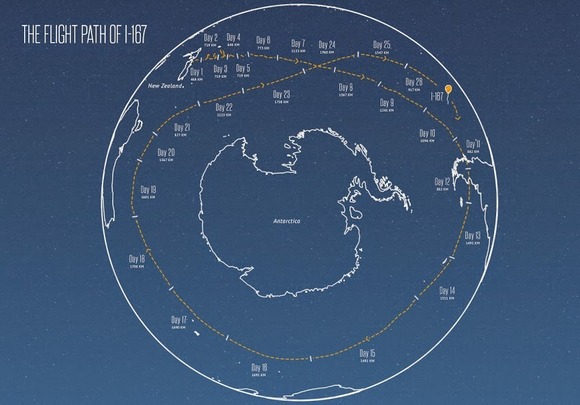 IMAGE: GOOGLE
IMAGE: GOOGLEWheeeeeeee...!
While it may seem like fun and games, Project Loon’s larger goal is to use high-altitude balloons to “connect people in rural and remote areas, help fill coverage gaps, and bring people back online after disasters.”
Currently, the project is test-flying balloons to learn more about wind patterns, and to test its balloon designs. In the past nine months, the project team has used data it’s accumulated during test flights to “refine our prediction models and are now able to forecast balloon trajectories twice as far in advance.”
It also modified the balloon’s air pump (which pumps air in and out of the balloon) to operate more efficiently, which in turn helped the balloon stay on course in this latest test run.
Project Loon’s next step toward universal Internet connection is to create “a ring of uninterrupted connectivity around the 40th southern parallel,” which it expects to pull off sometime this year.
Monday, March 24. 2014
WiFi capability embedded in 68% of all consumer electronics sold in the US
Via Slash Gear
-----

Just about every electronic device that we buy today has WiFi hardware embedded inside. Our game consoles like the PS3, PS4, Xbox One, and portable devices all ship with wireless connectivity. Strategy Analytics has issued a new report that shows 68% of all consumer electronics devices sold in the US now include WiFi capability.
When the report is expanded to look at the entire world, 57% of all consumer electronics devices have WiFi embedded. There are 4 billion WiFi enabled devices in use around the world today. Breaking that down, Strategy Analytics says that is about seven WiFi equipped devices for every home.
Looking around my house, I have more devices that that with multiple smartphones, game consoles, tablets, DVRs with WiFi, and more. It’s easy to see how 4 billion WiFi devices can be in use around the world. The research firm predicts that by 2017 there will be over 7 billion WiFi devices in use globally.
The most common WiFi equipped devices on the market are mobile phones and tablets. Those two product categories account for 59% of all WiFi enabled CE devices shipped in 2013. Mobile PCs is the next biggest category accounting for 9% of WiFi devices shipped. The massive difference in percentage between mobile phones and tablets compared to mobile computers makes sense with the computer market on the decline. Key growth areas for WiFi moving forward will be in cameras, wireless audio speakers, smart TVs and DVRs according to Strategy Analytics.
Ericsson and Philips unite to brighten cities and provide mobile broadband connectivity through smart street lighting
Via Ericson
-----
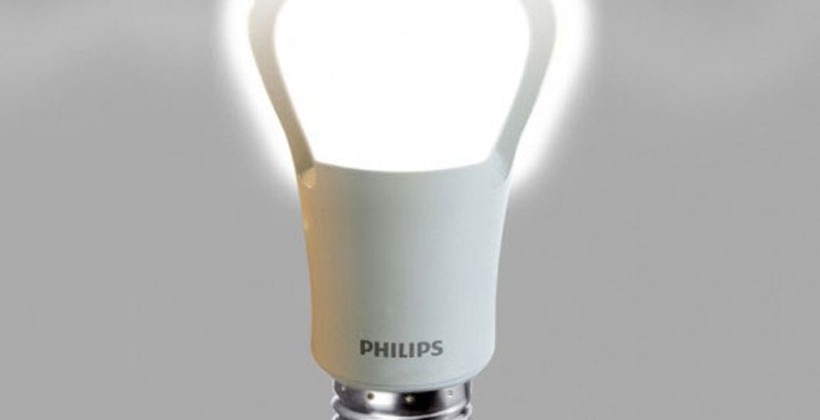
- City populations grow by 7,500 people per hour and mobile data traffic is expected to grow ten times by 2019, increasing the need for sustainable lighting and enhanced mobile capacity and coverage in cities
- New connected street lighting model solves two issues simultaneously: offering city officials an innovative way to afford next generation energy efficient LED lighting to meet sustainability goals, and enabling network operators to offer improved city-wide mobile broadband and app coverage
- Called "Zero Site" by Ericsson, connected lighting solution integrates telecom equipment into light poles enabling telecom operators to improve mobile network performance while reducing urban clutter
- Citizens will benefit from improved mobile network coverage for data communications and enhanced safety with brighter, well lit streets
Ericsson (NASDAQ:ERIC) and Royal Philips (NYSE: PHG, AEX: PHIA), the global leader in lighting, have jointly launched an innovative new connected LED street lighting model. The partnership solves two major issues that cities are facing today: providing citizens with improved network performance in dense urban areas as well as high quality, public lighting that is energy efficient.
Philips and Ericsson combine the benefits of mobile connectivity and LED lighting in a ''lighting-as-a-service'' model for cities. It allows city authorities to offer space within their connected lighting poles to network service providers for mobile broadband infrastructure.
Philips will now offer cities LED street lighting that can include mobile telecoms equipment from Ericsson. Mobile operators working with Ericsson for mobile broadband infrastructure will be able to rent space in the poles. In this way, mobile network operators will be able to improve data coverage and capacity for citizens, resulting in enhanced mobile broadband services. The model also accelerates the payback time for city infrastructure, by making the up-front costs of installing and managing these systems more affordable, so reducing the strain on city budgets.
Philips LED street lighting can generate energy savings of 50 to 70 percent, with savings reaching 80 percent when coupled with smart controls - as validated by a study conducted by The Climate Group in 12 of the world's largest cities. The study also showed that citizens prefer the white light of LED lighting, citing a greater sense of safety and improved visibility compared to the orange glow of traditional high pressure sodium systems.
Ericsson President and CEO Hans Vestberg says: "This is a tremendous solution using ICT and partnerships to address the megatrend of urbanization. City populations are increasing at the rate of 7,500 people per hour, but our world is not geographically expanding. Meanwhile, our ConsumerLab research shows that internet connectivity is one of the top five factors for satisfaction in city life. This Zero Site solution is the kind of innovation that offers a way for people to succeed in the Networked Society."
Frans van Houten, President and CEO of Philips, says: "This new connected LED street lighting model is another example of us bringing the Internet of Things to life and demonstrates the capabilities of light beyond illumination. We are offering lighting as a service that scales with a city's needs and enables city officials to offer their citizens a more connected, energy efficient and safer urban environment, while preserving existing budgets and resources to improve the livability of their city."
To meet the demand for coverage and capacity, mobile operators need to improve, densify and add many more radio cell sites in dense areas. The new connected street light pole, designed to house Ericsson's cutting edge suite of small cell products, offers network operators new possibilities to find the right site location. It will also help to scale the deployment of mobile broadband technology beyond traditional sites - a key enabler for evolving heterogeneous networks.
Friday, March 07. 2014
Scientists develop a lie detector for tweets
Via The Telegraph
-----
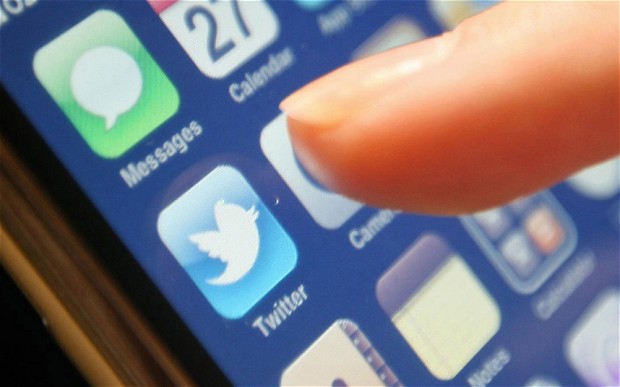
The Twitter logo displayed on a smart phone Photo: PA
Scientists have developed the ultimate lie detector for social media – a system that can tell whether a tweeter is telling the truth.
The creators of the system called Pheme, named after the Greek mythological figure known for scandalous rumour, say it can judge instantly between truth and fiction in 140 characters or less.
Researchers across Europe are joining forces to analyse the truthfulness of statements that appear on social media in “real time” and hope their system will prevent scurrilous rumours and false statements from taking hold, the Times reported.
The creators believe that the system would have proved useful to the police and authorities during the London Riots of 2011. Tweeters spread false reports that animals had been released from London Zoo and landmarks such as the London Eye and Selfridges had been set on fire, which caused panic and led to police being diverted.
Kalina Bontcheva, from the University of Sheffield’s engineering department, said that the system would be able to test information quickly and trace its origins. This would enable governments, emergency services, health agencies, journalists and companies to respond to falsehoods.
Thursday, March 06. 2014
Here’s what the internet’s arteries look like in 2014
Via GIGAOM
-----
Great news for connectivity connoisseurs: the analyst firm TeleGeography just published this year’s edition of its world map, featuring all the submarine cable systems that comprise the arteries of the internet.
The map also shows the cables’ landing points (easier to see if you zoom in on the interactive version), which is handy for those who take an interest in the current surveillance scandal. Why is British intelligence so good at tapping cables? Here’s why – so many of them pass through the U.K.:
The 2014 edition includes 263 cables that are lit (in service), and 22 that should be lit by the end of 2015, so 285 cable systems in total. Last year’s map showed 244 cables, and the year before that just 150, so the cable-laying boom of a few years back has definitely slowed down.
Unfortunately this year’s edition lacks a neat feature of Telegeography’s 2012 and 2013 maps, which was a breakdown of how much of the cable systems’ capacity is actually being used. It also doesn’t have the 2013 edition’s Olde Worlde appeal. On the plus side, it does offer a good breakdown of cable faults over recent years, cable-laying ships and maintenance zones, if that’s your thing.
One cable system that’s not on the map, probably because it will only go live in 2016, is the Asia Africa Europe-1 (AAE-1) cable that was detailed on Tuesday. AAE-1 will run from South-East Asia to Africa and Europe via the Middle East, and yesterday the backing consortium announced membership including the likes of China Unicom, PCCW, Etisalat and Ooredoo.
Tuesday, October 22. 2013
A plan to turn every lightbulb into an ultra-fast alternative to Wi-Fi
Via Quartz
-----
Current wireless networks have a problem: The more popular they become, the slower they are. Researchers at Fudan University in Shanghai have just become the latest to demonstrate a technology that transmits data as light instead of radio waves, which gets around the congestion issue and could be ten times faster than traditional Wi-Fi.
In dense urban areas, the range within which Wi-Fi signals are transmitted is increasingly crowded with noise—mostly, other Wi-Fi signals. What’s more, the physics of electromagnetic waves sets an upper limit to the bandwidth of traditional Wi-Fi. The short version: you can only transmit so much data at a given frequency. The lower the frequency of the wave, the less it can transmit.

Li-Fi doesn’t work in the dark or outdoors, but it only has to be a supplement to existing wireless networks to be valuable.AP Photo/Kin Cheung
But what if you could transmit data using waves of much higher frequencies, and without needing a spectrum license from your country’s telecoms regulator? Light, like radio, is an electromagnetic wave, but it has about 100,000 times the frequency of a Wi-Fi signal, and nobody needs a license to make a light bulb. All you need is a way to make its brightness flicker very rapidly and accurately so it can carry a signal.
The idea sounds daft: Who would want to sit under a flickering bulb? But Li-Fi, a standard proposed just two years ago, is seeing rapid technological progress.
First, data are transmitted to an LED light bulb—it could be the one illuminating the room in which you’re sitting now. Then the lightbulb is flicked on and off very quickly, up to billions of times per second. That flicker is so fast that the human eye cannot perceive it. (For comparison, the average energy-saving compact fluorescent bulb already flickers between 10,000 and 40,000 times per second.) Then a receiver on a computer or mobile device—basically, a little camera that can see visible light—decodes that flickering into data. LED bulbs can be flicked on and off quickly enough to transmit data around ten times as fast the fastest Wi-Fi networks. (If they could be manipulated faster, the bandwidth would be even higher.)

If you’ve ever used a solar-powered calculator, you already know how to connect to Li-Fi.Oledcomm
Li-Fi has one big drawback compared to Wi-Fi: you, or rather your device, need to be within sight of the bulb. It wouldn’t necessarily need to be a special bulb; in principle, overhead lights at work or at home could be wired to the internet. But it would mean that, unlike with Wi-Fi, you couldn’t go into the next room unless there were wired bulbs there too.
However, a new generation of ultrafast Wi-Fi devices that we’re likely to start using soon face a similar limitation. They use a higher range of radio frequencies, which aren’t as crowded with other signals (at least for now), and have a higher bandwidth, but, like visible light, cannot penetrate walls.
Engineers and a handful of startups, like Oledcomm, have been experimenting with Li-Fi technology. The Fudan University team unveiled an experimental Li-Fi network in which four PCs were all connected to the same light bulb. Other researchers are working on transmitting data via different colors of LED lights—imagine, for example, transmitting different signals through each of the the red, green and blue LEDs inside a multi-colored LED light bulb.
Because of its limitations, Li-Fi won’t do away with other wireless networks. But it could supplement them in congested areas, and replace them in places where radio signals need to be kept to a minimum, like hospitals, or where they don’t work, such as underwater.Wednesday, October 02. 2013
Scientists want to turn smartphones into earthquake sensors
Via The Verge
-----

For years, scientists have struggled to collect accurate real-time data on earthquakes, but a new article published today in the Bulletin of the Seismological Society of America may have found a better tool for the job, using the same accelerometers found in most modern smartphones. The article finds that the MEMS accelerometers in current smartphones are sensitive enough to detect earthquakes of magnitude five or higher when located near the epicenter. Because the devices are so widely used, scientists speculate future smartphone models could be used to create an "urban seismic network," transmitting real-time geological data to authorities whenever a quake takes place.
The authors pointed to Stanford's Quake-Catcher Network as an inspiration, which connects seismographic equipment to volunteer computers to create a similar network. But using smartphone accelerometers would be cheaper and easier to carry into extreme environments. The sensor will need to become more sensitive before it can be used in the field, but the authors say once technology catches up, a smartphone accelerometer could be the perfect earthquake research tool. As one researcher told The Verge, "right from the start, this technology seemed to have all the requirements for monitoring earthquakes — especially in extreme environments, like volcanoes or underwater sites."
Tuesday, October 01. 2013
France sanctions Google for European privacy law violations
Via pcworld
-----
Google faces financial sanctions in France after failing to comply with an order to alter how it stores and shares user data to conform to the nation's privacy laws.
The enforcement follows an analysis led by European data protection authorities of a new privacy policy that Google enacted in 2012, France's privacy watchdog, the Commission Nationale de L'Informatique et des Libertes, said Friday on its website.
Google was ordered in June by the CNIL to comply with French data protection laws within three months. But Google had not changed its policies to comply with French laws by a deadline on Friday, because the company said that France's data protection laws did not apply to users of certain Google services in France, the CNIL said.
The company "has not implemented the requested changes," the CNIL said.
As a result, "the chair of the CNIL will now designate a rapporteur for the purpose of initiating a formal procedure for imposing sanctions, according to the provisions laid down in the French data protection law," the watchdog said. Google could be fined a maximum of €150,000 ($202,562), or €300,000 for a second offense, and could in some circumstances be ordered to refrain from processing personal data in certain ways for three months.
What bothers France
The CNIL took issue with several areas of Google's data policies, in particular how the company stores and uses people's data. How Google informs users about data that it processes and obtains consent from users before storing tracking cookies were cited as areas of concern by the CNIL.
In a statement, Google said that its privacy policy respects European law. "We have engaged fully with the CNIL throughout this process, and we'll continue to do so going forward," a spokeswoman said.
Google is also embroiled with European authorities in an antitrust case for allegedly breaking competition rules. The company recently submitted proposals to avoid fines in that case.
Monday, September 09. 2013
Why cards are the future of the web
-----
Cards are fast becoming the best design pattern for mobile devices.
We are currently witnessing a re-architecture of the web, away from pages and destinations, towards completely personalised experiences built on an aggregation of many individual pieces of content. Content being broken down into individual components and re-aggregated is the result of the rise of mobile technologies, billions of screens of all shapes and sizes, and unprecedented access to data from all kinds of sources through APIs and SDKs. This is driving the web away from many pages of content linked together, towards individual pieces of content aggregated together into one experience.

The aggregation depends on:
- The person consuming the content and their interests, preferences, behaviour.
- Their location and environmental context.
- Their friends’ interests, preferences and behaviour.
- The targeting advertising eco-system.
If the predominant medium of our time is set to be the portable screen (think phones and tablets), then the predominant design pattern is set to be cards. The signs are already here…
Twitter is moving to cards
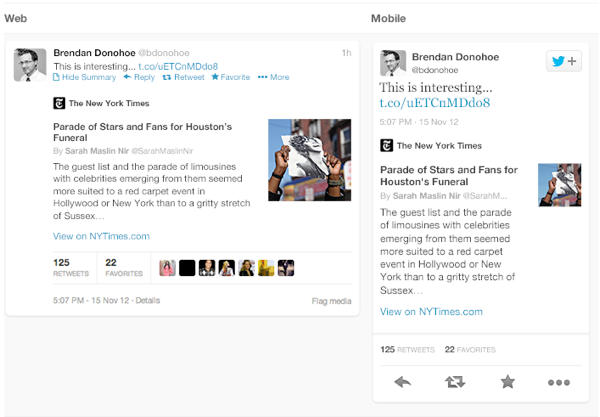
Twitter recently launched Cards, a way to attached multimedia inline with tweets. Now the NYT should care more about how their story appears on the Twitter card (right hand in image above) than on their own web properties, because the likelihood is that the content will be seen more often in card format.
Google is moving to cards

With Google Now, Google is rethinking information distribution, away from search, to personalised information pushed to mobile devices. Their design pattern for this is cards.
Everyone is moving to cards

Pinterest (above left) is built around cards. The new Discover feature on Spotify (above right) is built around cards. Much of Facebook now represents cards. Many parts of iOS7 are now card based, for example the app switcher and Airdrop.
The list goes on. The most exciting thing is that despite these many early card based designs, I think we’re only getting started. Cards are an incredible design pattern, and they have been around for a long time.
Cards give bursts of information
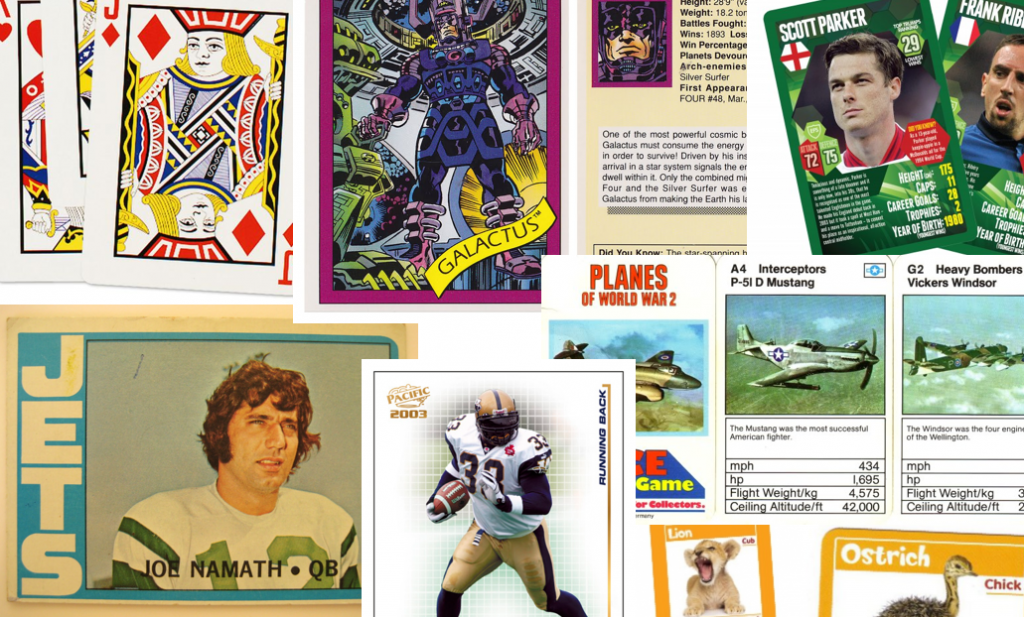
Cards as an information dissemination medium have been around for a very long time. Imperial China used them in the 9th century for games. Trade cards in 17th century London helped people find businesses. In 18th century Europe footmen of aristocrats used cards to introduce the impending arrival of the distinguished guest. For hundreds of years people have handed around business cards.
We send birthday cards, greeting cards. My wallet is full of debit cards, credit cards, my driving licence card. During my childhood, I was surrounded by games with cards. Top Trumps, Pokemon, Panini sticker albums and swapsies. Monopoly, Cluedo, Trivial Pursuit. Before computer technology, air traffic controllers used cards to manage the planes in the sky. Some still do.
Cards are a great medium for communicating quick stories. Indeed the great (and terrible) films of our time are all storyboarded using a card like format. Each card representing a scene. Card, Card, Card. Telling the story. Think about flipping through printed photos, each photo telling it’s own little tale. When we travelled we sent back postcards.
What about commerce? Cards are the predominant pattern for coupons. Remember cutting out the corner of the breakfast cereal box? Or being handed coupon cards as you walk through a shopping mall? Circulars, sent out to hundreds of millions of people every week are a full page aggregation of many individual cards. People cut them out and stick them to their fridge for later.

Cards can be manipulated.

In addition to their reputable past as an information medium, the most important thing about cards is that they are almost infinitely manipulatable. See the simple example above from Samuel Couto Think about cards in the physical world. They can be turned over to reveal more, folded for a summary and expanded for more details, stacked to save space, sorted, grouped, and spread out to survey more than one.
When designing for screens, we can take advantage of all these things. In addition, we can take advantage of animation and movement. We can hint at what is on the reverse, or that the card can be folded out. We can embed multimedia content, photos, videos, music. There are so many new things to invent here.
Cards are perfect for mobile devices and varying screen sizes. Remember, mobile devices are the heart and soul of the future of your business, no matter who you are and what you do. On mobile devices, cards can be stacked vertically, like an activity stream on a phone. They can be stacked horizontally, adding a column as a tablet is turned 90 degrees. They can be a fixed or variable height.
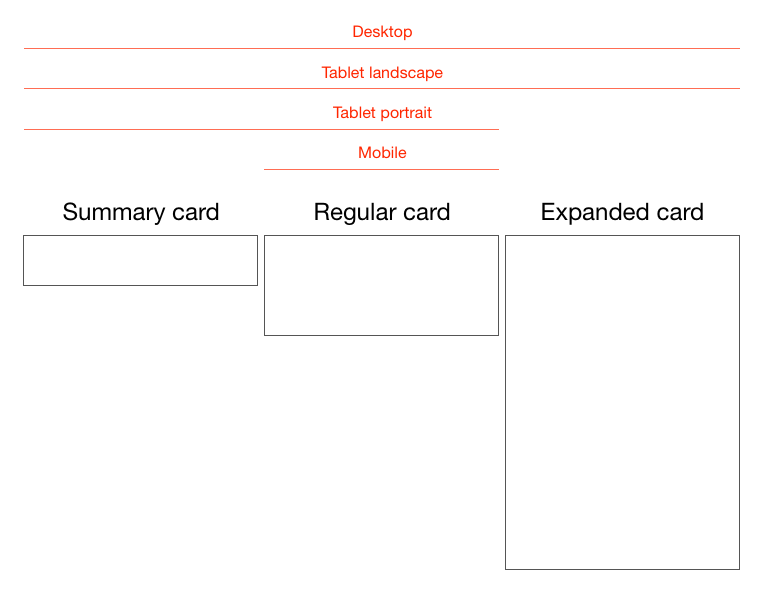
Cards are the new creative canvas
It’s already clear that product and interaction designers will heavily use cards. I think the same is true for marketers and creatives in advertising. As social media continues to rise, and continues to fragment into many services, taking up more and more of our time, marketing dollars will inevitably follow. The consistent thread through these services, the predominant canvas for creativity, will be card based. Content consumption on Facebook, Twitter, Pinterest, Instagram, Line, you name it, is all built on the card design metaphor.
I think there is no getting away from it. Cards are the next big thing in design and the creative arts. To me that’s incredibly exciting.
Wednesday, September 04. 2013
The wireless network with a mile-wide range that the “internet of things” could be built on
Via quartz
-----

Robotics engineer Taylor Alexander needed to lift a nuclear cooling tower off its foundation using 19 high-strength steel cables, and the Android app that was supposed to accomplish it, for which he’d just paid a developer $20,000, was essentially worthless. Undaunted and on deadline—the tower needed a new foundation, and delays meant millions of dollars in losses—he re-wrote the app himself. That’s when he discovered just how hard it is to connect to sensors via the standard long-distance industrial wireless protocol, known as Zigbee.
It took him months of hacking just to create a system that could send him a single number—which represented the strain on each of the cables—from the sensors he was using. Surely, he thought, there must be a better way. And that’s when he realized that the solution to his problem would also unlock the potential of what’s known as the “internet of things” (the idea that every object we own, no matter how mundane, is connected to the internet and can be monitored and manipulated via the internet, whether it’s a toaster, a lightbulb or your car).
The result is an in-the-works project called Flutter. It’s what Taylor calls a “second network”—an alternative to Wi-Fi that can cover 100 times as great an area, with a range of 3,200 feet, using relatively little power, and is either the future of the way that all our connected devices will talk to each other or a reasonable prototype for it.

“We have Wi-Fi in our homes, but it’s not a good network for our things,” says Taylor. Wi-Fi was designed for applications that require fast connections, like streaming video, but it’s vulnerable to interference and has a limited range—often, not enough even to cover an entire house.
For applications with a very limited range—for example anything on your body that you might want to connect with your smartphone—Bluetooth, the wireless protocol used by keyboards and smart watches, is good enough. For industrial applications, the Zigbee standard has been in use for at least a decade. But there are two problems with Zigbee: the first is that, as Alexander discovered, it’s difficult to use. The second is that the Zigbee devices are not open source, which makes them difficult to integrate with the sort of projects that hardware startups might want to create.
Flutter’s nearest competitors, Spark Core and Electric Imp, both use Wi-Fi, which limits their usability to home-bound projects like adding your eggs to the internet of things and klaxons that tell you when your favorite Canadian hockey team has scored a goal.
Flutter’s other differentiator is cost; a Flutter radio costs just $20,
which still allows Taylor a healthy margin above the $6 in parts that
comprise the Flutter.
Making Flutter cheap means that hobbyists can connect that many more devices—say, all the lights in a room, or temperature and moisture sensors in a greenhouse. No one is quite sure what the internet of things will lead to because the enabling technologies, including cheap wireless radios like Flutter, have yet to become widespread. The present day internet of things is a bit like where personal computers were around the time Steve Wozniak and Steve Jobs were showing off their Apple I at the Palo Alto home-brew computer club: It’s mostly hobbyists, with a few big corporations sniffing around the periphery.

“I think the internet of things is not going to start with products, but projects,” says Taylor. His goal is to use the current crowd-funding effort for Flutter to pay for the coding of the software protocol that will run Flutter, since the microchips it uses are already available from manufacturers. The resulting software will allow Flutter to create a “mesh network,” which would allow individual Flutter radios to re-transmit data from any other Flutter radio that’s in range, potentially giving hobbyists or startups the ability to cover whole cities with networks of Flutter radios and their attached sensors.
Quicksearch
Popular Entries
- The great Ars Android interface shootout (130614)
- Norton cyber crime study offers striking revenue loss statistics (100710)
- MeCam $49 flying camera concept follows you around, streams video to your phone (99552)
- Norton cyber crime study offers striking revenue loss statistics (56939)
- The PC inside your phone: A guide to the system-on-a-chip (56910)
Categories
Show tagged entries
Syndicate This Blog
Calendar
|
|
November '25 | |||||
| Mon | Tue | Wed | Thu | Fri | Sat | Sun |
| 1 | 2 | |||||
| 3 | 4 | 5 | 6 | 7 | 8 | 9 |
| 10 | 11 | 12 | 13 | 14 | 15 | 16 |
| 17 | 18 | 19 | 20 | 21 | 22 | 23 |
| 24 | 25 | 26 | 27 | 28 | 29 | 30 |

